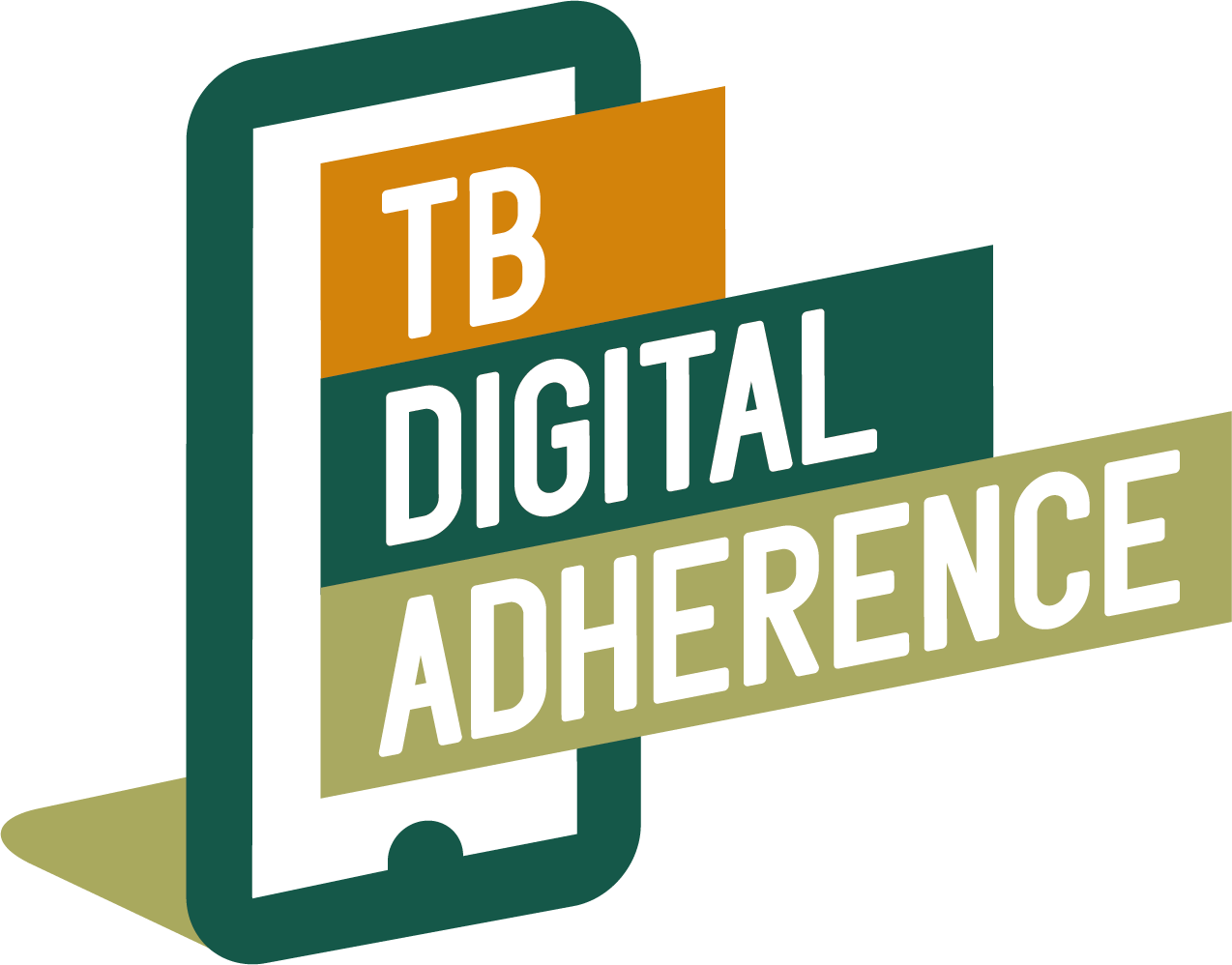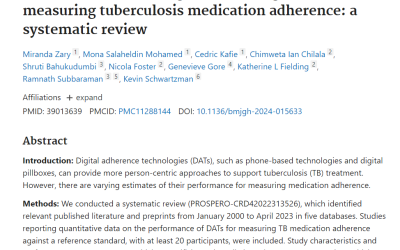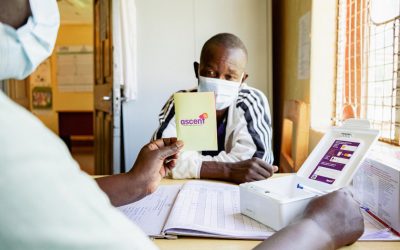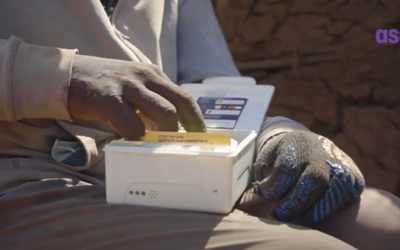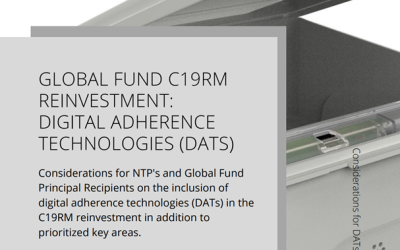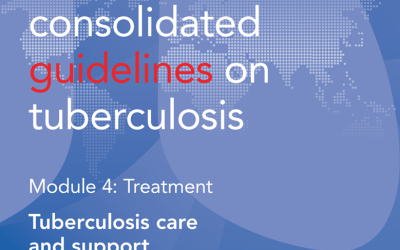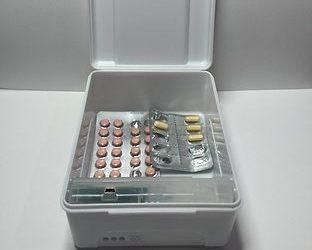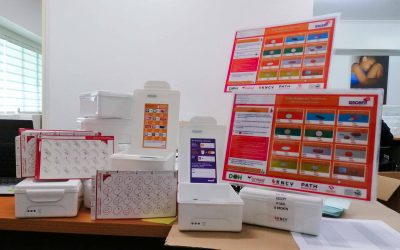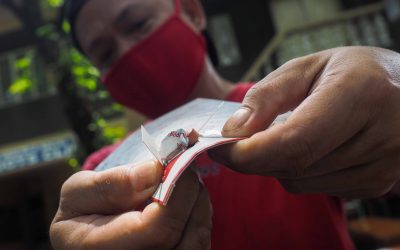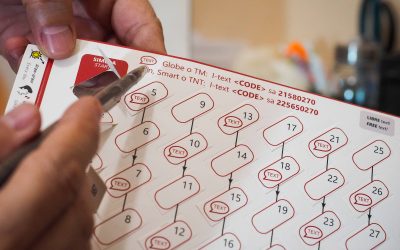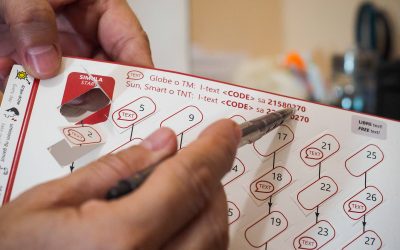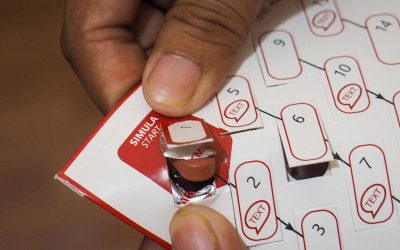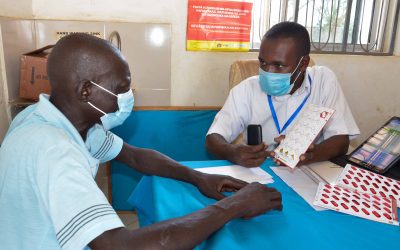Publications
Research on Digital Adherence Technologies
Research on Digital Adherence Technologies Explore the latest research on Digital Adherence Technologies (DATs)Stay ahead with our collection on the latest research on Digital Adherence Technologies (DATs). These scientific publications have the potential to inform the implementation and enhancement of DAT innovations, guiding developers, funders, and National Tuberculosis Programs (NTPs) in shaping their EndTB strategies supported by digital tools. These resources are essential for...
Technical Brief: 5 Country Experiences with Digital Adherence Technologies
Based on the experience of implementing digital adherence technologies at scale in five different contexts, this technical brief serves to
highlight and summarize the ASCENT project implementation experiences with 3 technologies.
Budgeting for Digital Adherence Technologies in preparation for Global Fund applications
In preparation for Global Fund 2023-2025 submissions the Global DAT Task Force secretariat hosted a webinar to provide guidance on developing a budget for digital adherence technology implementation in national TB programs.
Considerations for the inclusion of DATs in the Global Fund Covid-19 Response Mechanism Reinvestment
The Global DAT Task Force secretariat has created a document on considerations for the inclusion of Digital Adherence Technologies, as a tool to support tuberculosis treatment alongside other requests linked to the identified C19RM reinvestment priorities.
Digital Adherence Technologies in the WHO Guidelines
The World Health Organization published their updated consolidated guidelines on Tuberculosis for treatment in July 2022.
As a part of the guidelines there were multiple references to the use of digital adherence technologies as a tool in TB treatment.
Cost and Cost-Effectiveness of a Digital Adherence Technology for Tuberculosis Treatment Support in Uganda
Digital adherence technologies like 99DOTS are increasingly considered as an alternative to directly observed
therapy for tuberculosis (TB) treatment supervision. We evaluated the cost and cost-effectiveness of 99DOTS in a high-TB burden setting.
Using electronic medication monitoring to guide differential management of tuberculosis patients at the community level in China
In settings such as China, where universal implementation of directly observed therapy (DOT) is not feasible, innovative approaches are needed to support patient adherence to TB treatment. The electronic medication monitor (EMM) is one of the digital technologies recommended by the World Health Organization (WHO), but evidence from implementation studies remains sparse. In this study, we evaluated acceptance of the EMM among health care workers and patients while implementing the device for differential TB patient management at the community level.
The effect of electronic monitoring feedback on medication adherence and clinical outcomes: A systematic review
Objective: This study aims to assess the efficacy of Electronic Monitoring Feedback (EMF) as an intervention to improve medication adherence (i.e. dose- or full adherence) and clinical outcomes in adult patients.
Outcomes and implementation challenges of using daily treatment regimens with an innovative adherence support tool among HIV-infected tuberculosis patients in Karnataka, India: a mixed-methods study
In India, a new care package consisting of (i) daily regimen with fixed-dose combination drugs, collected once-a-month and self-administered by the patient, (ii) ‘one stop service’ at antiretroviral treatment (ART) centre for both HIV and tuberculosis (TB) treatment and (iii) technology-enabled adherence support (99DOTS, which required patients to give a missed phone call after consuming drugs) was piloted for treatment of TB among HIV-infected TB patients. Conventional care included intermittent regimen (drugs consumed thrice-weekly) delivered under direct observation of treatment supporter and the patients needing to visit TB and HIV care facilities, separately for treatment.
Smartphone-enabled video-observed versus directly observed treatment for tuberculosis: a multicentre, analyst-blinded, randomised, controlled superiority trial
Directly observed treatment (DOT) has been the standard of care for tuberculosis since the early 1990s, but it is inconvenient for patients and service providers. Video-observed therapy (VOT) has been conditionally recommended by WHO as an alternative to DOT. We tested whether levels of treatment observation were improved with VOT.
The impact of digital health technologies on tuberculosis treatment: a systematic review
Digital technologies are increasingly harnessed to support treatment of persons with tuberculosis (TB). Since in-person directly observed treatment (DOT) can be resource intensive and challenging to implement, these technologies may have the potential to improve adherence and clinical outcomes. We reviewed the effect of these technologies on TB treatment adherence and patient outcomes.
Pilot evaluation of a second-generation electronic pill box for adherence to Bedaquiline and antiretroviral therapy in drug-resistant TB/HIV co-infected patients in KwaZulu-Natal, South Africa
The introduction of Bedaquiline, the first new antimycobacterial drug in over 40 years, has highlighted the critical importance of medication adherence in drug-resistant tuberculosis (DR-TB) treatment to prevent amplified drug-resistance and derive sustained benefit. Real-time electronic dose monitoring (EDM) accurately measures adherence and allows for titration of adherence support for anti-retroviral therapy (ART). The goal of this study was to evaluate the accuracy and acceptability of a next-generation electronic pillbox (Wisepill RT2000) for Bedaquiline-containing TB regimens.
Opportunities to improve digital adherence technologies and TB care using human-centered design
Digital adherence technologies (DATs) have emerged as a promising means of supporting and supervising patients being treated for TB. However, despite considerable enthusiasm and wide-scale implementation, there has been variable uptake and engagement by patients and providers, and few clinical trials and programmatic data have demonstrated an improvement in treatment outcomes. Human-centered design (HCD) is a well-established methodology that utilizes qualitative research methods to understand the values and motivations of users, and systematically incorporates user input into the design or adaptation of products and interventions. We applied the HCD methodology to characterize adherence challenges facing TB patients and identified opportunities to adapt 99DOTS (a low-cost DAT) to better address these challenges.
Evaluating the potential costs and impact of digital health technologies for tuberculosis treatment support
Ensuring adherence and support during treatment of tuberculosis (TB) is a major public health challenge. Digital health technologies could help improve treatment outcomes. We considered their potential cost and impact on treatment for active or latent TB in Brazil.
An Inca trail to the Holy Grail: digital medication adherence support for TB care
We live in an era of effective drugs to treat TB, but these only work if taken consistently. The failure to take medication as prescribed, also referred to as ‘‘treatment non-adherence’’, is associated with significantly increased treatment failure, development of multidrug-resistant TB (MDR-TB), increased mortality and greater economic burden for TB patients and society. Fortunately, in this issue of the Journal, a research group from Peru has helped to guide our way forwards with publication of a TB adherence intervention study in Latin America. We will come to this study shortly, but first some background information to better understand the field.
Usability of a Medication Event Reminder Monitor System (MERM) by Providers and Patients to Improve Adherence in the Management of Tuberculosis
Here we report a usability study of a newly-designed, modular electronic monitor product, called the MERM (Medication Event and Reminder Monitor), that is compatible with TB medication formats and supply chains in resource-limited settings. This study, done in a rural setting in China, showed that the use of the MERM for EM of TB medications was associated with a high degree of user performance, acceptability, and satisfaction among both TB patients and medical staff.
Cost comparison of wirelessly vs. directly observed therapy for adherence confirmation in anti-tuberculosis treatment
SETTING: A US clinic treating patients entering the continuation phase of treatment for Mycobacterium tuberculosis.
OBJECTIVE: To compare the costs of direct confirmation of treatment using wirelessly observed therapy (WOT) vs. standard of care utilizing World Health Organization-recommended 7-day and 3-day directly observed therapy (DOT).
Adherence interventions and outcomes of tuberculosis treatment: A systematic review and meta-analysis of trials and observational studies
Incomplete adherence to tuberculosis (TB) treatment increases the risk of delayed culture conversion with continued transmission in the community, as well as treatment failure, relapse, and development or amplification of drug resistance. We conducted a systematic review and meta-analysis of adherence interventions, including directly observed therapy (DOT), to determine which approaches lead to improved TB treatment outcomes.
A randomised controlled trial to evaluate a medication monitoring system for TB treatment
BACKGROUND:
Adherence to TB treatment and therefore treatment success could be improved using digital adherence technology.
OBJECTIVE:
To evaluate the effectiveness of a medication event reminder monitor system (MERM) on treatment success and treatment adherence in patients with drug-susceptible pulmonary TB in Perú.
Implementation of Medication Event Reminder Monitors among patients diagnosed with drug susceptible tuberculosis in rural Viet Nam: A qualitative study
Despite the criticality of adherence to tuberculosis treatment, there is paucity of rigorous experimental research exploring the efficacy of interventions to promote adherence and a greater lack of inquiry addressing the integral role of adherence behaviour. The aim of this formative study was to examine the way in which the Wisepill evriMED Medication Event Reminder Monitor (MERM) was used among outpatients with drug susceptible pulmonary tuberculosis.
Video Directly Observed Therapy to support adherence with treatment for tuberculosis in Vietnam: A prospective cohort study
Ensuring patients fully adhere to their treatment is a major challenge for TB control programmes in resource-limited settings. This study was conducted three outpatient tuberculosis clinics in Hanoi, Vietnam. We aimed to evaluate the feasibility of using asynchronous Video Directly Observed Therapy (VDOT) to support treatment adherence among patients with bacteriologically confirmed pulmonary tuberculosis.
Acceptability and Feasibility of Digital Adherence Technology (DAT) in TB REACH project in Ukraine (wave 6)
The goal of this descriptive study is to understand the factors that promote or hinder the implementation and/or performance of the DAT tools in supporting treatment adherence. The study uses a standardized approach to collecting data across all TB REACH DAT projects14 focusing mainly on two components of implementation research (IR) framework, acceptability and feasibility.
Digital monitoring technologies could enhance tuberculosis medication adherence in Uganda: Mixed methods study
Effective administration of tuberculosis therapy remains challenging. The recommended strategy of direct observed therapy is challenging and its implementation has been limited in many settings. Digital adherence technologies could be promising patient-centered strategies for monitoring adherence. However, few quality studies have assessed patients’ experiences with these technologies.
OBJECTIVE
To explore TB patients’ perceptions of a digital adherence intervention composed of a digital adherence monitor and SMS texts.
Video directly observed therapy for supporting and monitoring adherence to tuberculosis treatment in Uganda: a pilot cohort study
INTRODUCTION
Nonadherence to treatment remains an obstacle to tuberculosis (TB) control worldwide. The aim of this study was to evaluate the feasibility of using video directly observed therapy (VDOT) for supporting TB treatment adherence in Uganda.
Synchronous and asynchronous video observed therapy (VOT) for tuberculosis treatment adherence monitoring and support
This paper synthesizes literature through December 2018 to describe existing VOT approaches, summarize evidence, identify knowledge gaps, evaluate VOT strengths and weaknesses, and examine patient and provider factors influencing VOT feasibility and acceptability.
Iterative Adaptation of a Tuberculosis Digital Medication Adherence Technology to Meet User Needs: Qualitative Study of Patients and Health Care Providers Using Human-Centered Design Methods.
This study aimed to optimize a well-known digital adherence technology, 99DOTS, for end user needs in Uganda. We describe the findings of the ideation phase of the human-centered design methodology to adapt 99DOTS according to a set of design principles identified in the previous inspiration phase.
Video observed therapy (VOT) and medication adherence for TB patients: RCT in Moldova
The effectiveness of Video Observed Therapy (VOT) for treating Tuberculosis (TB) has not been measured in low and middle-income countries (LMICs), where more than 95% of TB cases and deaths occur. In this study, we analyse the effectiveness, and patient cost-difference, of VOT compared to clinic-based Directly Observed Therapy (DOT) in improving medication adherence in Moldova, a LMIC in Eastern Europe.
Digital Adherence Technologies for TB: Translating Surveillance to Care
The first large-scale implementation of the digital adherence surveillance models in India is examined in order understand the justifying rationale and the exact mechanism through which digital surveillance is translated to care for the TB patient.
Use of Smartphone-Based Video Directly Observed Therapy (vDOT) in Tuberculosis Care: Single-Arm, Prospective Feasibility Study
The goal of the research was to assess the feasibility and acceptability of vDOT for adherence monitoring within a resource-limited, high TB burden setting of India.
A pilot project: 99DOTS information communication technology-based approach for tuberculosis treatment in Rajkot district
The objective of this study was to evaluate treatment adherence rate and treatment outcome of 99DOTS-information communication technology (ICT)-based approach for tuberculosis (TB) management.
Acceptability of the Medication Event Reminder Monitor for Promoting Adherence to Multidrug-Resistant Tuberculosis Therapy in Two Indian Cities: Qualitative Study of Patients and Health Care Providers
Objective: This study aims to assess the MERM’s acceptability to patients and health care providers (HCPs) during pilot implementation in India’s public sector MDR-TB program.
Explaining Differences in the Acceptability of 99DOTS, a Cell Phone–Based Strategy for Monitoring Adherence to Tuberculosis Medications: Qualitative Study of Patients and Health Care Providers
Objective: This study aims to understand reasons for variability in the acceptance and use of 99DOTS by TB patients and health care providers (HCPs).
Electronic pillbox-enabled self-administered therapy versus standard directly observed therapy for tuberculosis medication adherence and treatment outcomes in Ethiopia (SELFTB): protocol for a multicenter randomized controlled trial
This study aims to evaluate the effectiveness of pillbox-enabled self-administered therapy (SAT) compared to standard DOT on adherence to TB medication and treatment outcomes in Ethiopia. It also aims to assess the usability, acceptability, and cost-effectiveness of the intervention from the patient and provider perspectives.
Telemedicine Technologies and Tuberculosis Management: A Randomized Controlled Trial
Background: Since 1990s, directly observed therapy (DOT) has been the standard-of-care for tuberculosis (TB), although it is cumbersome for patients as well as service providers. For raising implementation, an alternative delivery method with good potential is telehealth. The current study assessed the clinical and cost benefit of video directly observed therapy (VDOT), compared with DOT service.
Electronic medication monitor for people with tuberculosis: Implementation experience from thirty counties in China
Among people with tuberculosis notified in 30 counties in China (July-December 2018) where EMM supported self-administered treatment was suggested to all those eligible (no communication impairment, ambulatory care), we assessed the i) proportion eligible for using EMM ii) uptake of EMM and factors associated and iii) treatment adherence, including the proportion shifted to DOT.
Evaluation of a medication monitor-based treatment strategy for drug-sensitive tuberculosis patients in China: study protocol for a cluster randomised controlled trial
Treatment for drug-sensitive tuberculosis (TB) is taken for at least 6 months and problems with adherence are common. Therefore, there is substantial interest in the possible use of eHealth interventions to support patients to take their treatment. Electronic medication monitors have been shown to improve adherence to TB medication, but the impact on clinical outcomes is unknown. We aim to evaluate the impact of a medication monitor-based treatment strategy for drug-sensitive TB patients on a composite poor outcome measured over 18 months from start of TB treatment.
Effectiveness of Electronic Reminders to Improve Medication Adherence in Tuberculosis Patients: A Cluster-Randomised Trial
Mobile text messaging and medication monitors (medication monitor boxes) have the potential to improve adherence to tuberculosis (TB) treatment and reduce the need for directly observed treatment (DOT), but to our knowledge they have not been properly evaluated in TB patients. We assessed the effectiveness of text messaging and medication monitors to improve medication adherence in TB patients.
Video-observed treatment for tuberculosis patients in Belarus: Findings from the first programmatic experience
Belarus, an upper-middle-income country in eastern Europe with a population of 9.5 million reports high levels of multidrug-resistant tuberculosis (resistance to rifampicin and isoniazid), which requires many patients to start long second-line treatment regimens each year: 1949 patients in 2015 alone. These patients need directly observed treatment daily due to the high risk of loss to treatment follow-up. Regular travel to treatment services incurs substantial effort, expense and time lost in transit for the patients. Among multidrug-resistant tuberculosis patients starting treatment in Belarus in 2013, 12% interrupted medication. The Ministry of Health of Belarus and its Republic Scientific and Practical Centre for Pulmonology and Tuberculosis are investing in digital technologies to further strengthen the national tuberculosis programme. We describe the recent introduction of VOT in Belarus.
Evaluation of the Accuracy of 99DOTS, a Novel Cellphone-based Strategy for Monitoring Adherence to Tuberculosis Medications: Comparison of Digital Adherence Data With Urine Isoniazid Testing
99DOTS is a cellphone-based strategy for monitoring tuberculosis medication adherence. In a sample of 597 Indian patients with tuberculosis, we compared 99DOTS’ adherence assessments against results of urine isoniazid tests collected during unannounced home visits. 99DOTS had suboptimal accuracy for measuring adherence, partly due to poor patient engagement with 99DOTS.
Digital adherence technology for tuberculosis treatment supervision: A stepped-wedge cluster-randomized trial in Uganda
Adherence to and completion of tuberculosis (TB) treatment remain problematic in many high-burden countries. 99DOTS is a low-cost digital adherence technology that could increase TB treatment completion.
